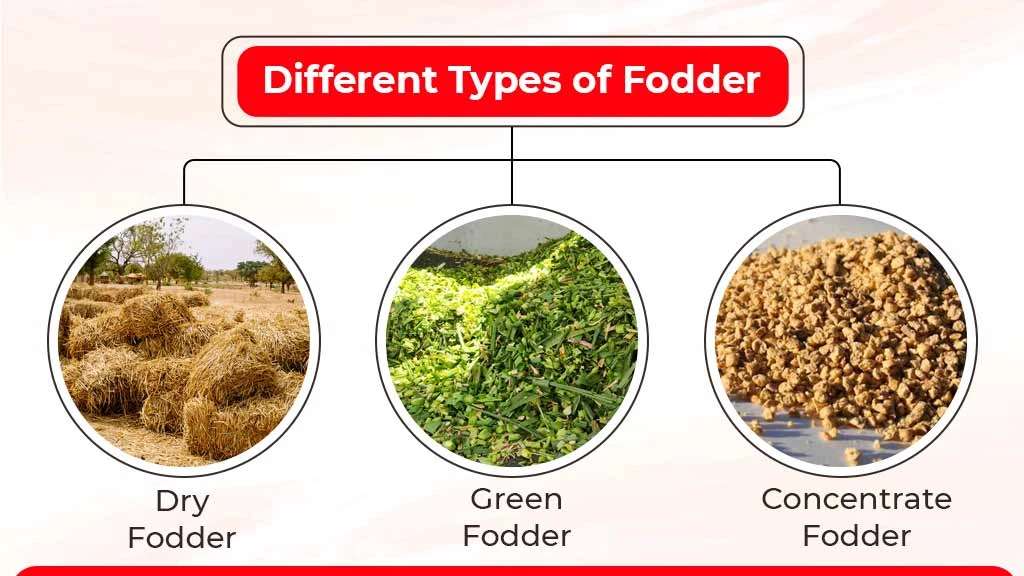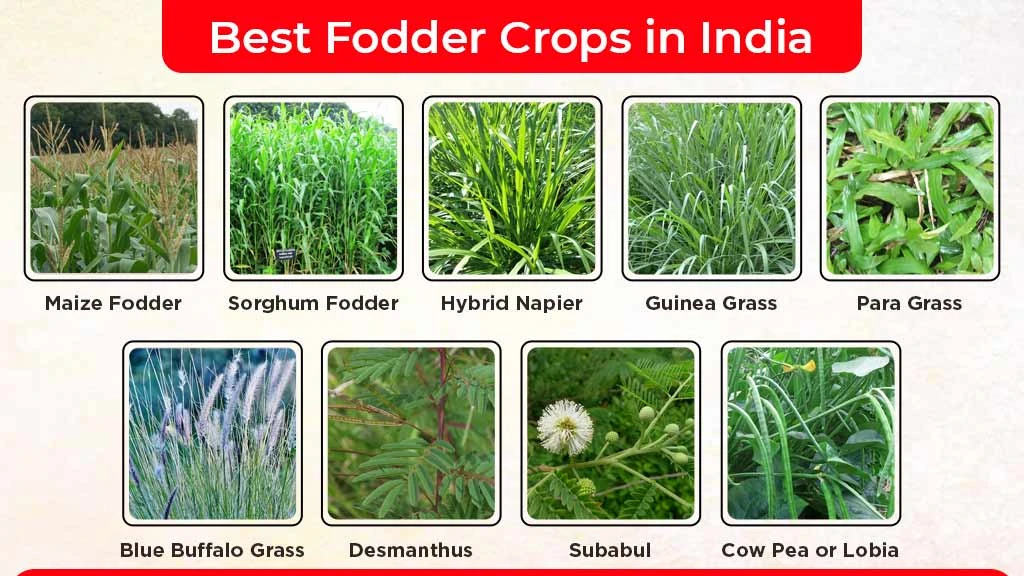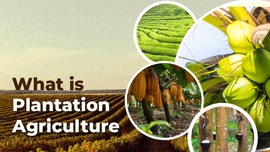Best Fodder Crops grown by Indian Farmers: A Complete List

Fodder crops are those crops which are grown for the animal feed for their proper nourishment so that they can provide quality products like milk, eggs, meat, etc. There are different types of fodder grown in India having their unique characteristics and features. Today’s blog is all about the best fodder crops for Indian farmers, so if you want to get the complete detail about fodder, then keep on reading the entire blog.
Table of Contents
- What is Fodder?
- What are the Different Types of Fodder?
- Best Fodder Crops for Livestock in India
- Major Fodder Crops Cultivated Based on Agro Climatic Zones
What is Fodder?
Fodder is defined as agricultural food that is primarily grown to feed farm animals like sheep fodder, cow fodder, fodder for horses, pigs, etc. to get high quality products in return. The popular fodder includes straw, hay, silage, compressed and palleted feed, sprout grains and legumes. Fodder like Napier and Guinea are the cheapest type of fodder which provide essential proteins, carbohydrates, minerals and fats to the animals. Popular cereal crops fodder such as Maize and Sorghum are highly energetic while the leguminous crops like Lucerne and Cowpea are rich in protein.
What are the Different Types of Fodder?

Dry, green and concentrate are the different types of fodder grown in India. Let’s discuss all the types of fodder in more detail.
Dry Fodder
After the harvesting of crops, the residue or leftover part of the crops is known as dry fodder. It is preserved for the time when fresh fodder is not available. This type of fodder requires proper maintenance; it should be stored in a dry, well-ventilated place to prevent moisture. The best way to store dry fodder is to make bales. Examples include wheat straw, paddy straw, and maize stover.
Green Fodder
Feed made from green crops such as legume crops, grass crops and cereal crops is known as green fodder. This fodder is grown in warm temperatures, tropical and sub-tropical regions. Examples of green fodder are maize, sorghum, guinea, cowpea, etc.
Concentrate Fodder
Concentrate fodder is a mixture of grains and other ingredients including protein, oils and vitamins. Concentrate feed is further diluted and mixed with the main feed to produce a supplement. Maize meal, groundnut cake, limestone, rice bran and wheat bran are common examples of concentrate fodder.
Best Fodder Crops for Livestock in India

Maize Fodder, Sorghum Fodder, Co-4 Grass, Hybrid Napier, etc. are some of the best fodder crops for livestock in India. Let’s understand all the fodder crops in detail.
Maize Fodder
Maize is an annual crop which requires well drained and fertile soil to grow. It can be grown throughout the year with proper irrigation facilities. It is usually grown as a Kharif crop as it is sown in June- July, but in south India it is grown as a Rabi crop. The seed rate of maize fodder should be 40 kg/ha. The average yield of green fodder is 40-50 t/ha and the dry matter yield is 10-15 t/ha. It should be harvested when the cob is in the milky stage.
Sorghum Fodder
Sorghum is a drought resistant annual crop. This is cultivated for both grains and fodder. It grows on almost every soil except sandy soils. It requires tropical climate with a temperature ranging from 25 °C to 35 °C and an annual rainfall of 300-350 mm. After the flowering stage of the green fodder, sorghum can be harvested, which is usually 60 to 65 days.
Hybrid Napier
Hybrid Napier is a perennial grass fodder. This type of fodder has more leaves than Napier grass and is more vigorous and higher in fodder yield and quality. The protein content ranges from 8% to 11%. Co.CN4 is a recent hybrid Napier which is a cross between Cumbu Co.8 and Napier grass F.T.461. It should be harvested in 75 to 80 days after planting and subsequent harvests at intervals of 45 days.
Guinea Grass
Guinea grass is a fast growing highly palatable perennial grass which is usually tall and tufted. It has a short creeping rhizome. The protein content of this grass ranges between 4% and 14%. It is mostly suitable for almost all types of soil except clayey soil. The seed rate of this grass is 2.5 kg/ha. This grass should be cut within 75- 80 days after germination or 45 days after planting of slips. It requires subsequent cuts at intervals of 45 days. The yield of green fodder is 175 tonnes /ha per year in 8 cuts. It can be intercropped with Hedge Lucerne (Velimasal) at 3:1 ratio. Hamil, PPG -14, Makuni, Rivers-dale are some of the popular varieties.
Para Grass
Para grass is a perennial grass cultivated in humid regions. It is grown in seasonally flooded valleys and lowlands. Waterlogged soils are best suited for this crop. However, it can also be grown in sandy soils if water supply is sufficient. It can be planted at any time, but June - July planting is advisable under rainfed conditions. It is propagated exclusively by stem cuttings. It should be cut within 75 to 80 days after planting and the subsequent cuts at 40-45 days interval. It has an average green fodder yield of 80-100 t/ha.
Blue Buffalo Grass
This is a perennial grass which grows well in dry lands under rain fed conditions. It requires well drained soil with high calcium content. The seed rate of this grass is 6-8 kg/ha. Cenchrus cilliaris and C. setigerus are the two most common varieties of this grass. The first harvest should be done on 70th or 75th days after sowing and subsequently 4-6 cuts depending on growth. It has a pure crop yield of 40 t/ha.
Desmanthus
Desmanthus is a perennial crop which is grown throughout the year under irrigation and its fodder cultivation takes place during June - October as a rainfed crop. The seeds of this crop should be sown at 20 kg/ha in solid stands on the side of the ridges over the lines where fertilizers are applied at a depth of 2 cm and cover with soil. Proper irrigation is required for its growth. The first cut can be done on 90th day after sowing at 50 cm height. It has a green fodder yield of 80-100 t/ha/year.
Subabul
It is a fodder tree which produces broader seeds. The most suitable sowing time for this tree is June-July. The plant can be harvested within 6 months after planting. Make sure to cut it only when the trunk has attained at least 3 cm diameter or one seed production cycle is completed. The trees can be cut at 90 cm to 100 cm height from ground level. It has a pure crop yield of about 80 to 100 t/ha of green fodder. Hawaiian giant (lvory coast) and Co1 are the popular varieties.
Cow Pea or Lobia
Cow pea or Lobia is an annual crop, which can be grown in tropics, sub-tropic and warm temperature regions. It is suitable for year-round cultivation and can be grown in all seasons. It is used for green form, for hay making or for ensiling in mixtures with sorghum or maize. The recommended seed rate of Lobia is 40 kg/ha. It can be harvested in 50 to 55 days after sowing (50% flowering stage). The popular varieties of cow pea are Co 5, Russian giant, and EC 4216.
Major Fodder Crops Cultivated Based on Agro Climatic Zones
- North Zone: In North zone, the major crops cultivated are Maize + Cowpea, Sorghum + Cowpea, Berseem + Mustard, and Hybrid Napier or Setaria interplanted with Cowpea.
- Southern Zone: Sorghum + Cowpea, maize + Cowpea, Hybrid Napier or Guinea Grass interplanted with Lucerne, and Sudan Grass + Cowpea are the most cultivated fodder crops in southern zone.
- Eastern Zone: Eastern zone consists of Maize+ Cowpea, teosinte + Rice Bean, Berseem + Mustard, Hybrid Napier or Setaria Grass interplanted with Subabul as its major fodder crops.
- Western and Central Zone: Bajra + Guar (Clusterbean), Annual Lucerne, M.P. Chari + Cowpea, and Hybrid Napier or Guinea Grass interplanted with Cowpea are the major fodder crops cultivated in the Western or Central Zone.


Related Blogs












